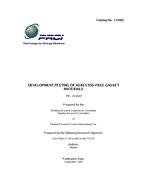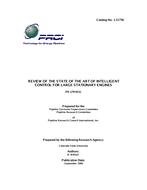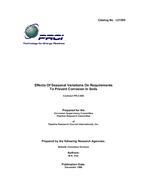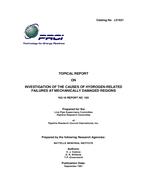Provide PDF Format
PRCI PR-003-9113
- Fracture Control Technology For Natural Gas Pipelines
- Report / Survey by Pipeline Research Council International, 12/01/1993
- Publisher: PRCI
$40.00$80.00
L51691e
Battelle Memorial Institute
Need: Operational integrity of gas-transmission pipelines is a goal of all operators. Pipeline integrity is achieved by planning, controlling, and monitoring a number of elements, all of which contribute to the total pipeline system integrity. Elements that affect overall pipeline integrity are pipeline design, pipe specification, pipe transportation and handling, pipeline construction and inspection, preservice testing, and operation and maintenance practices. Fracture control is part of a number of these elements. This research report and software satisfies the industry need for a comprehensive description of the methods of preventing and controlling fracture initiation and propagation.
Benefit: An ideal goal of any fracture control plan would be to specify pipe characteristics that would only result in leaks in a pipeline regardless of the flaw size and type. This is not possible because even infinitely tough pipe can rupture if a large enough flaw is introduced. Thus, fracture control plans must balance both initiation resistance and propagation resistance. This comprehensive research report and software provides guidance and references for creation of a fracture control and/or total pipeline integrity plan.
Result: The fracture initiation section of this report presents formulations for predicting the relationships between critical defect size and fracture initiation toughness. These formulations can be used as a basis for specifying pipe toughness for new lines or for estimating the flaw tolerance on existing lines. Relationships are presented for operating temperatures above and below the fracture initiation transition temperature. This temperature can be defined using the Charpy V-notch impact test or the drop-weight-tear test. The defects considered are axial notches or cracks, dents, and dents and gouges (mechanical damage).
The fracture propagation section of this report presents formulations for predicting the fracture mode and fracture length in the event of a rupture. These formulations can also be used to specify pipe toughness and transition temperature requirements for new lines to control the mode of fracture and the length of a fracture if one should initiate. Brittle and ductile fracture arrest requirements for onshore and offshore lines are presented. Also, crack arrestor concepts are described for those lines that cannot arrest a fracture, either because of the gas decompression characteristics or because of existing toughness properties.
Battelle Memorial Institute
Need: Operational integrity of gas-transmission pipelines is a goal of all operators. Pipeline integrity is achieved by planning, controlling, and monitoring a number of elements, all of which contribute to the total pipeline system integrity. Elements that affect overall pipeline integrity are pipeline design, pipe specification, pipe transportation and handling, pipeline construction and inspection, preservice testing, and operation and maintenance practices. Fracture control is part of a number of these elements. This research report and software satisfies the industry need for a comprehensive description of the methods of preventing and controlling fracture initiation and propagation.
Benefit: An ideal goal of any fracture control plan would be to specify pipe characteristics that would only result in leaks in a pipeline regardless of the flaw size and type. This is not possible because even infinitely tough pipe can rupture if a large enough flaw is introduced. Thus, fracture control plans must balance both initiation resistance and propagation resistance. This comprehensive research report and software provides guidance and references for creation of a fracture control and/or total pipeline integrity plan.
Result: The fracture initiation section of this report presents formulations for predicting the relationships between critical defect size and fracture initiation toughness. These formulations can be used as a basis for specifying pipe toughness for new lines or for estimating the flaw tolerance on existing lines. Relationships are presented for operating temperatures above and below the fracture initiation transition temperature. This temperature can be defined using the Charpy V-notch impact test or the drop-weight-tear test. The defects considered are axial notches or cracks, dents, and dents and gouges (mechanical damage).
The fracture propagation section of this report presents formulations for predicting the fracture mode and fracture length in the event of a rupture. These formulations can also be used to specify pipe toughness and transition temperature requirements for new lines to control the mode of fracture and the length of a fracture if one should initiate. Brittle and ductile fracture arrest requirements for onshore and offshore lines are presented. Also, crack arrestor concepts are described for those lines that cannot arrest a fracture, either because of the gas decompression characteristics or because of existing toughness properties.
Related Products
PRCI PR-3-505
Effects of Seasonal Variations on Requirements to Prevent Corrosion in Soils..
$148.00 $295.00





